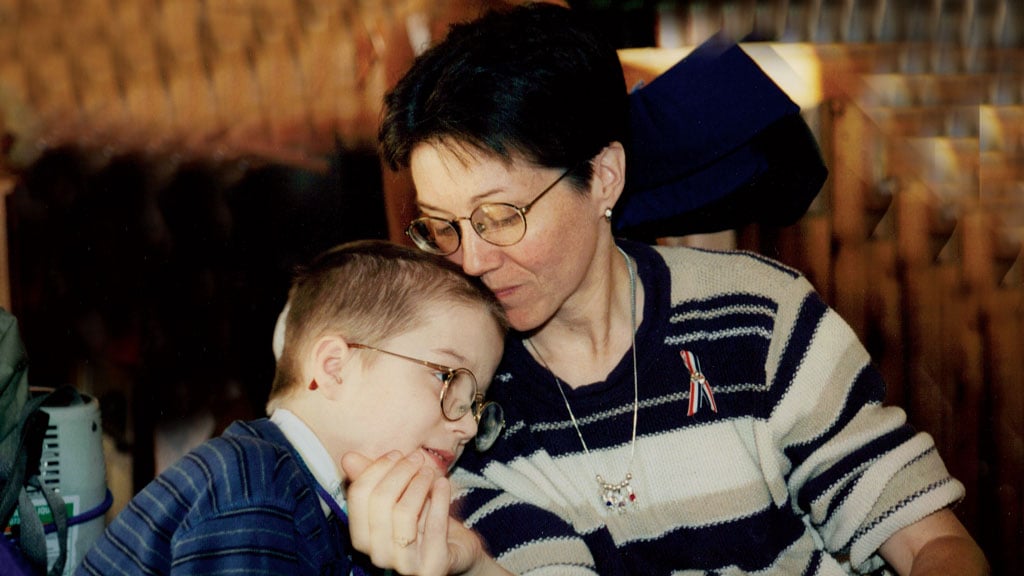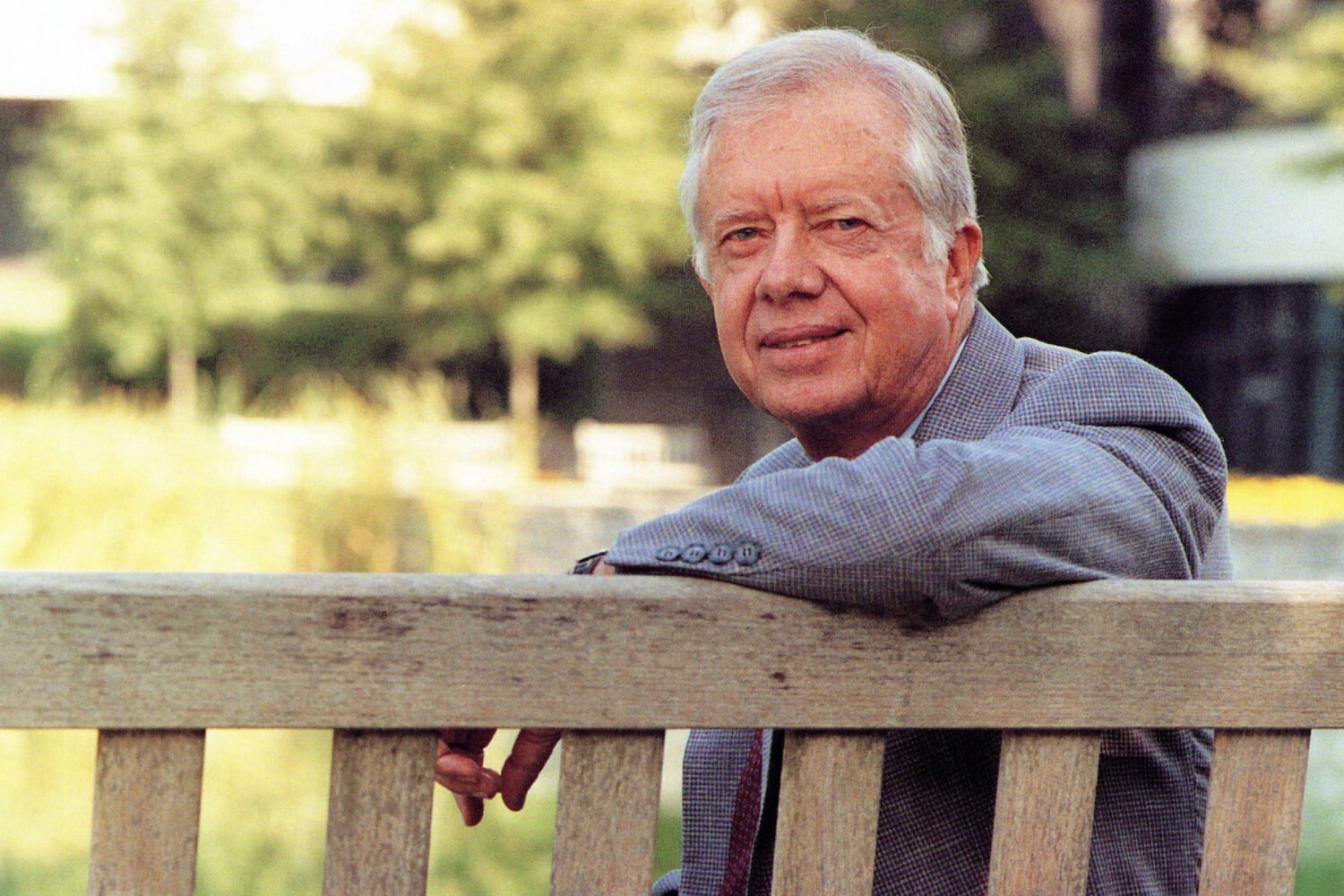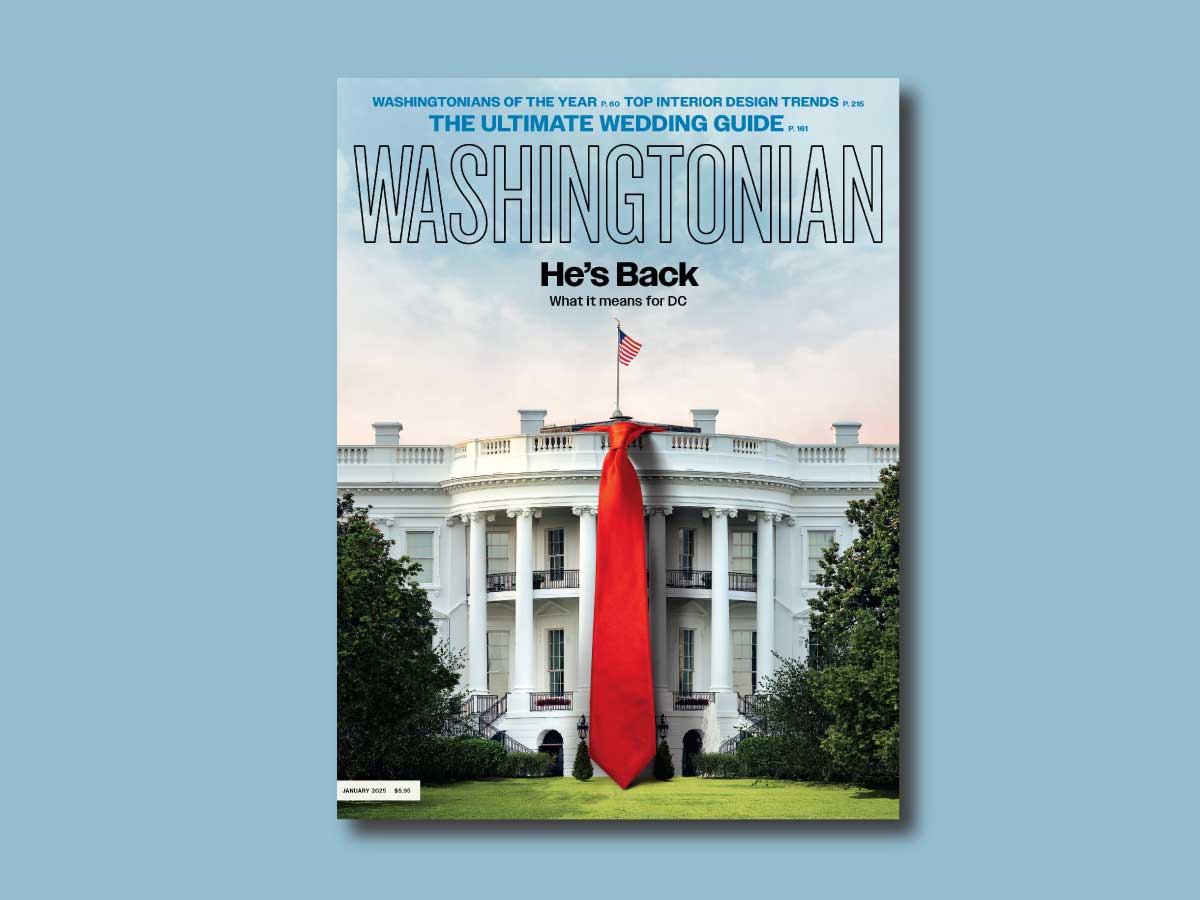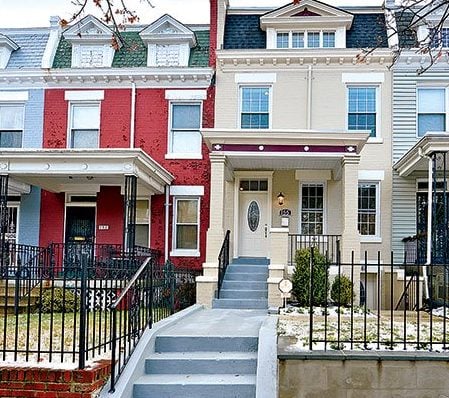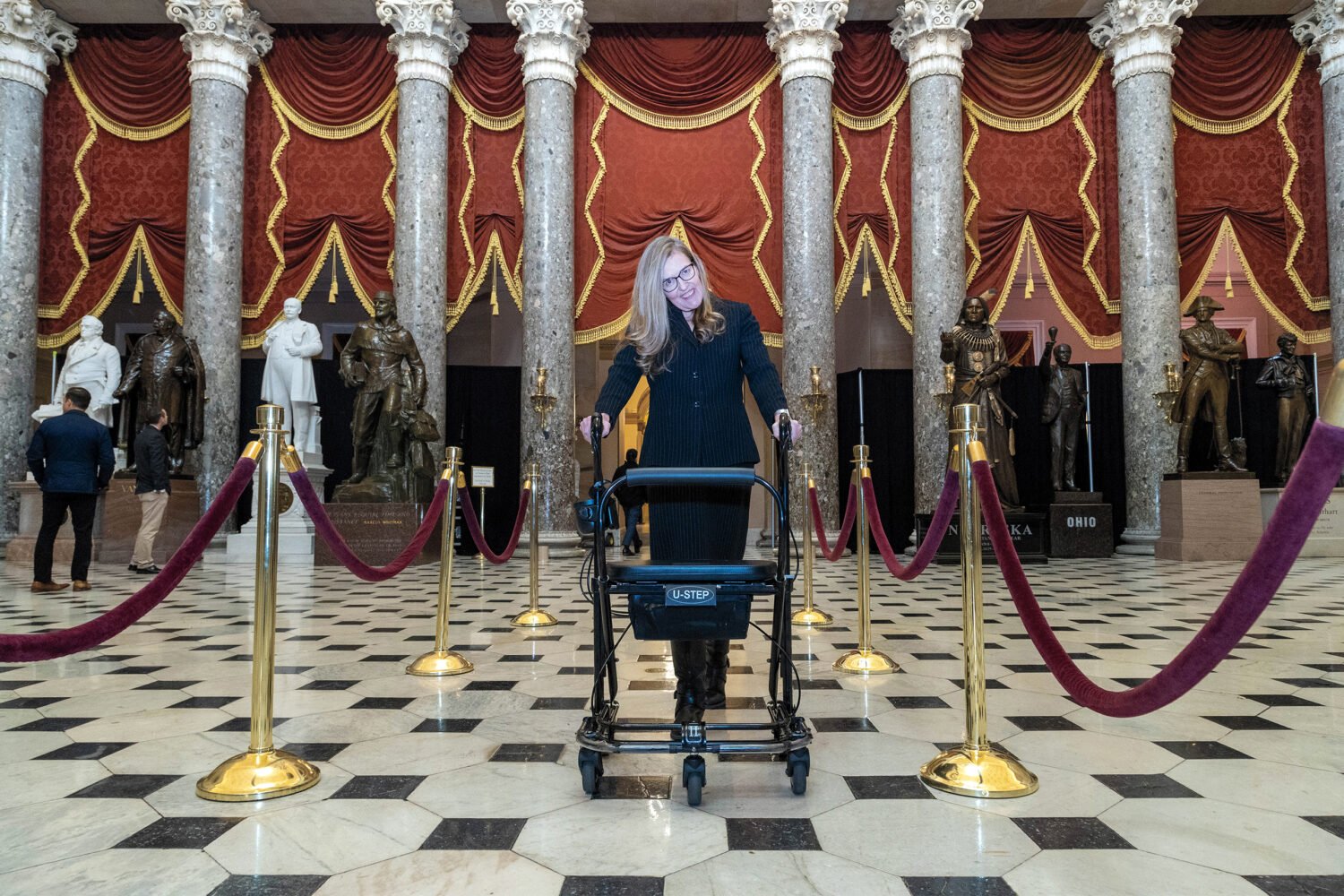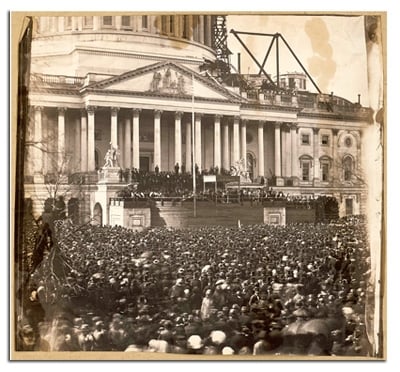
Gaslight shone from the windows of the Capitol. The old mahogany clock outside the Senate chamber ticked past midnight on March 4, 1861, as one of the most momentous days in America’s history—and in Washington’s—began.
Through the small hours of the night, the lawmakers argued, fulminated, cajoled. For years, this building had been the scene of mounting rancor: hailstorms of invective, showers of vitriol. Northerners had excoriated Southern “slave drivers”; Southerners had blasted Northern abolitionists. Legislative debates had degenerated into fistfights; senators had brandished revolvers on the floor.
But tonight was unprecedented. For the first time in history, the Senate had convened on a Sunday. Legislators reasoned that the Lord cared more about preserving the Union than about keeping the Sabbath. The body’s senior member, one of its last remaining moderates, rose to address his colleagues. “We are about to adjourn,” he said, hoarse with despair. “We have done nothing. Even the Senate of the United States, beholding this great ruin around them, beholding dismemberment and revolution going on, and civil war threatened as the result, have been able to do nothing; we have done absolutely nothing.”
Every person in the room knew that within a few hours, the moment would come that would almost certainly pitch the nation over the precipice. At noon, a dangerous and unfamiliar politician from Illinois—a man who had not even set foot in Washington for the past decade—would stand just a few yards away, on the east portico, and take the oath of office as 16th President of the United States. Already half the South had seceded in protest, and the rest seemed likely to follow. Whatever happened afterward, the country would never be the same.
Nor would its capital. The Civil War would change Washington more than any other event in its history. In 1861, Washington was like some third-world capitals today: an overgrown village in which the national government just happened to hold sway and a place where luxury hotels stood amid slums and open sewers. Charles Dickens had called it a “city of magnificent intentions.” Now, for the first time, the reality would start to match the dreams. And a capital built on—in fact built by—slavery would begin to embrace freedom.
The morning of Abraham Lincoln’s inauguration marked the dawn of a new Washington.
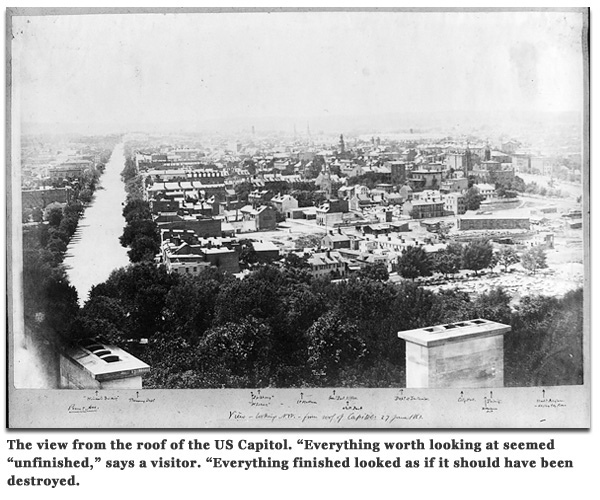
Like the nation itself, the Capitol building was a work in progress that winter. Several years earlier, a Southern statesman had overseen the first phases of an ambitious expansion, spreading the marble wings across the hilltop, ready to encompass all the delegations and committees, offices and bureaus that the rapidly growing federal union might require. To maintain proper scale, an architect was engaged to remove the old low-rise curve of the roof and replace it with a soaring dome of cast iron.
Then lawmakers busied themselves with deciding what kind of statue should crown the new structure. Taking a break from their debates over slavery, they found a rare moment of accord: The nation’s temple of democracy must be topped with a heroic statue of Freedom. But when the sculptor presented his plaster model of the goddess, sectional strife erupted again. On her head, the figure wore the Roman cap of liberty, a conventional bit of allegory. But the Southern politician who had taken such interest in the work, a man with a fine classical education, knew that the liberty cap had been used in ancient times to denote a slave who had been freed by his master. The gentleman—Jefferson Davis, then Secretary of War—protested lest such a symbol of abolitionism should crown the Capitol dome.
Now the statue, her objectionable cap replaced by a Roman helmet, lay in pieces, yet to be assembled, at a bronze foundry in Bladensburg. (Freedom’s casting was being overseen there by an expert metalworker, a slave named Philip Reid.) The dome itself rose half finished, wooden scaffolding and an enormous crane jutting above its open shell, which seemed to hang suspended between creation and destruction. Sage minds reflected that it symbolized the incomplete—and imperiled—Union. Walt Whitman suggested it be left as it was, with the derrick crane a more “poetical” emblem of America than a statue.
On the eve of the Civil War, the surrounding city was in an even less complete state. “A great, scrambling, slack-baked embryo of a city basking in the . . . sun like an alligator on the mud-bank of a bayou in July,” one British journalist called Washington. The District’s buildings were mostly ramshackle wooden affairs, with the exception of a few gleaming federal temples—most notably, apart from the Capitol, the White House, the Treasury Building, the Patent Office, and the General Post Office.
These were the edifices shown off to visitors—for the capital, despite its shortcomings, was becoming a mecca for foreign and American tourists. Not everyone appreciated the art and architecture. One New York aesthete sniffed that the House chamber, with its stained-glass ceiling and walls painted blazing red, had “a slight flavor of the Southwestern steamboat saloon,” while another suggested that if the South were going to secede, it was welcome to take with it all the paintings in the rotunda as well as the equestrian statue of Andrew Jackson in Lafayette Square.
“Everything worth looking at seemed unfinished,” said one visitor. “Everything finished looked as if it should have been destroyed generations before.” Pigs and goats foraged for scraps in the avenues laid out optimistically by L’Enfant at the end of the previous century: broad, empty thoroughfares that dead-ended amid cornfields. Not many years earlier, the great senator Henry Clay had been attacked by a billy goat in the middle of Pennsylvania Avenue, much to the delight of the newsboys and bootblacks who gathered to watch the contest between animal and statesman. A stalemate was achieved when the senator grabbed his adversary by both horns. “Let go, Mr. Clay, and run like blazes!” shouted one of the newsboys. Clay heeded his advice and sprinted up the avenue with the goat in pursuit.
Pennsylvania Avenue’s mud was so deep in springtime that you often had to walk several blocks before finding a safe place to cross, while Second Street had gotten so bad that one gentleman’s carriage toppled off the eroding curbside and into the adjacent Tiber Creek canal, drowning him. The capital’s sanitation system—if the term could be applied to a crude network of drainage ditches—was overtaxed. Typhoid and cholera often swept through the city; on the eve of James Buchanan’s inauguration in 1857, he and numerous members of his administration contracted virulent dysentery, an outbreak that killed as many as three dozen people.
The barely habitable Washington of 1861 seemed a kind of tacit argument against the very idea of a national government—or at least as evidence of that government’s inability to maintain its own existence effectively. “Secession was likely to be easy where there was so little to secede from,” wrote the memoirist and historian Henry Adams, who had moved to the city that winter.
Offices of the executive branch had an almost makeshift feel. The State Department possessed the atmosphere of a county courthouse, with a placard in the front hall listing the hours that the Secretary of State received callers. The War Department—which would soon be called upon to oversee millions of troops in defense of the Union—had 93 employees, including janitors and file clerks. Even the White House was open to more or less any citizen seeking a meeting with the President, who held court in a second-floor office with a pigeonhole desk and a scuffed walnut table piled high with papers.
The locals’ sole professional activity seemed to be the task of waiting: waiting in the White House to ask a favor, waiting for a bill to wend its way through congressional committees, waiting in a hotel bar for an elusive Cabinet patron to make his appearance. The archetypal Washingtonian had his feet propped on the end table, a newspaper in his hand, and a wad of tobacco in his cheek, the juice from which—depending on the expertise of the chewer—might end up in a nearby spittoon.
The real business of governing, then as now, was often transacted beyond the official precincts of power. In those last days before the war, the White House was overshadowed by another institution just two blocks away: the Willard Hotel.
Since its beginnings in President Madison’s time as a humble inn, the Willard had come to encompass almost an entire block. The folds and ravels of its endless corridors sheltered more political intrigue than the presidential mansion, while on any given morning, more business was legislated at the hotel’s breakfast tables than in Congress. A morning repast at the Willard might include oysters, roast pigeons, fresh shad, pig’s feet, and robins on toast—all washed down with official Washington’s two favorite digestifs: strong cigars and even stronger whiskey.
But the feature of Washington life that drew the most comment from newcomers—at least those from overseas or from the North—was slavery. The institution that had fueled decades of partisan rancor and that now threatened to break apart the Union seemed almost omnipresent in the capital.
Visitors remarked that the Willard and other big hotels were like intricate machines run wholly by the African-American servants who tended fireplaces, waited at table, and emptied chamber pots, sleeping at night on the bare hallway floors outside guests’ rooms in case their services were needed. Perched on the drivers’ seats of hackney cabs, enslaved men solicited fares outside the railway station; trudging alongside creaking wagons, enslaved women converged on the Central Market each day before dawn, bringing their masters’ cabbages and country hams from Maryland farms. It was slaves who, to a considerable degree, were building the new extensions of the Capitol, just as they had built the old Capitol and the White House more than half a century before.
When tourists dined at Absolom Shadd’s National Eating House on Pennsylvania Avenue, one of the District’s finest restaurants, it was slaves who tucked napkins into their collars before serving up specialties of the house: steamed Chesapeake crabs, spit-roasted game birds, and a buttery green soup made with sea-turtle meat imported from the Bahamas. Three of those slaves belonged to the hospitable Mr. Shadd himself—who was a free black man.
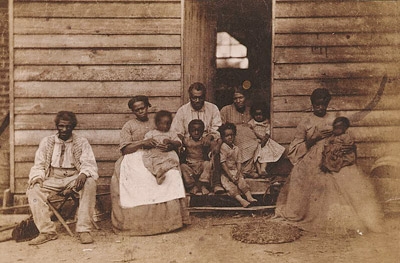
The categories of slave and free—terms that seemed so well defined in the speeches of abolitionist preachers and pro-slavery politicians—were all mixed up here in the shadow of the Capitol. The District’s free blacks lived in what sometimes seemed like slavery. In small ways, they were reminded that Washington was the capital of a country not their own. Any African-American was barred from entering the grounds of the Capitol—except for the servants and laborers. Socializing publicly with whites was almost unthinkable: If Absolom Shadd had tried to sit down for a meal in his own restaurant, the act might have sparked a riot. And each night at 10, when the bell of the Perseverance Fire Company at Eighth and Pennsylvania rang, all blacks—whether slave or free, ash haulers or restaurant owners—had to get off the streets or face arrest, followed sometimes by public flogging.
There were slave sales at auction houses in the neighborhood between Sixth and Ninth streets just above Pennsylvania Avenue. (Weschler’s, founded several decades after the Civil War, is the sole survivor today of that 19th-century auction district.) These firms sold real estate, housewares, furniture—and, when the opportunity presented itself, enslaved men and women.
Although the Compromise of 1850 had supposedly abolished this trade in the capital, it actually just forbade anyone to bring slaves into the District for the purpose of selling them out of state. It was still legal for a Washingtonian to put his slave up for public auction, and if the unfortunate man, woman, or child turned up the following week in one of the Alexandria slave pens across the Potomac, ready to be packed off aboard a New Orleans–bound schooner and resold to a Gulf Coast sugar planter—that, too, was within the law. In the same local newspapers reporting Lincoln’s inauguration, a Mr. G. Mason Graham of Louisiana advertised that he was in town to purchase “from twenty to fifty good Negroes.”
With just a few hours left until the swearing-in, as nighttime yielded to the gray light of dawn, the Senate did something few had expected: It made a final bid to save the Union. By a narrow margin, the lawmakers passed a constitutional amendment that had already cleared the House. If ratified by the states as the Thirteenth Amendment, it not only would bar Congress from interfering with slavery (referred to as “domestic institutions”) in any of the states but also would forbid the amendment to ever be repealed. In effect, it would guarantee slavery’s constitutional protection forever.
This work done, and after some final business, Vice President John Breckinridge banged his gavel and brought the Thirty-Sixth Congress of the United States to a close. The senators went off to wash and shave and to change their linens for the ceremony at noon.
Several hours earlier, Lincoln had risen in his suite at the Willard and sat down to make a few changes to his inaugural address. Just before noon, President Buchanan’s open barouche pulled up to collect Lincoln. The two men had little to say as the carriage rolled down Pennsylvania Avenue. The outgoing President seemed at a loss for pleasantries; the incoming one gazed down at the floorboards. Lincoln was so distracted that morning that he had walked out of the Willard without settling his $773.75 bill.
A short while later, as they waited inside the Capitol for the inaugural ceremony to begin, Buchanan finally drew Lincoln into a corner to offer a few words of wisdom. Lincoln’s secretary John Hay, who stood nearby, strained to listen. “I waited with boyish wonder and credulity,” he remembered, “to see what momentous counsels were to come from [Buchanan’s] gray and weatherbeaten head. Every word must have its value at such an instant. The ex-president said: ‘I think you will find the water of the right-hand well at the White House better than that of the left.’ ”
In those days, it was customary for the President to give his inaugural address before taking the oath of office. As Lincoln approached the rostrum, there was another awkward moment when he realized he had nowhere to put his stovepipe hat and walking stick. Someone stepped forward to help: Senator Stephen Douglas, the longtime rival Lincoln had defeated for the presidency. “If I cannot be President,” Douglas is said to have whispered, “I can at least be his hat-bearer.” Lincoln handed off his burden gratefully, reached into his coat pocket for the folded and much-corrected sheets of his speech, balanced a pair of spectacles on his nose, and began to read in his flat tenor voice.
Lincoln’s first inaugural address—or one section of it, anyhow—would be handed down as one of the nation’s greatest pieces of oratory. At the time, many listeners and readers found it alarming, if not appalling. Abolitionists such as Frederick Douglass—who called it a “double-tongued document”—were shocked when the new President endorsed the pro-slavery amendment just passed by Congress. The speech, Douglass said, offered little hope “for the cause of our down-trodden and heart-broken countrymen”—that is, the slaves.
Secessionists bristled when Lincoln expressed his determination not to surrender federal property in the South—such as Fort Sumter in Charleston Harbor, a Union stronghold at the epicenter of the rebellion. One Southern senator, muttering among the dignitaries on the Capitol steps, hurried off to telegraph Charleston: “Inaugural means war . . . war to the knife and knife to the hilt.”
Hardly anyone remarked on the closing lines of Lincoln’s address, the peroration that would be quoted so often in centuries to come:
We are not enemies, but friends. We must not be enemies. Though passion may have strained it must not break our bonds of affection. The mystic chords of memory, stretching from every battlefield and patriot grave to every living heart and hearthstone all over this broad land, will yet swell the chorus of the Union, when again touched, as surely they will be, by the better angels of our nature.
Lincoln’s plea failed to stave off the impending catastrophe. It would be more than four years before “the better angels of our nature” would again hold sway. In the meantime, that Southern senator’s prophecy would prove more accurate than the new President’s: There would indeed soon be war, to the knife and to the hilt. And one of the last lives it would claim would be Lincoln’s.
Within days after the South’s attack on Sumter in mid-April, troops began pouring into the capital. There were soon so many, one newspaperman reflected, that the streets at last resembled, in at least one respect, the imperial boulevards of Paris, Vienna, and St. Petersburg: Every third man you passed wore some sort of uniform. Troops bunked on makeshift cots among filing cabinets and display cases in the Patent Office, in the courtyard of the Treasury, even in the East Room of the White House.
In the Capitol, soldiers found the desk that until recently had been occupied by Jefferson Davis, bearing a placard with his name neatly inked. A custodian arrived to find the young men gouging chunks out of it with their bayonets, and he protested that it was the property not of the Confederate traitor but of the federal government they had just pledged their lives and honor to defend. Ignoring him, the soldiers divvied up the fragments as souvenirs.
These men formed the initial wave of many that would sweep through en route to the front lines. And with each influx of soldiers came other arrivals. First were ladies of pleasure—or business. “Beauty and sin done up in silk, with the accompaniment of lustrous eyes and luxurious hair, on every thoroughfare offer themselves for Treasury notes,” a Union officer wrote in his diary.
Of more significance were the federal bureaucracies that sprang up in support of the war effort. By the end of the conflict, the once-cozy War Department had overflowed into 11 nearby buildings. Doctors and nurses, clerks and mapmakers, supply contractors and stable hands all catered to the needs of the troops. The District’s population tripled in less than three years—from 61,000 in 1860 to nearly 200,000 by 1863. (The number of prostitutes, according to one block-by-block survey, totaled some 4,000.)
For a time, living conditions—and sanitation—grew worse. The Lincolns’ 11-year-old son, Willie, died of typhoid in February 1862, possibly as a result of playing along the banks of the nearby canal. Yet by war’s end, the District was becoming a true city. An English tourist compared Pennsylvania Avenue—“full of life and motion,” crowded with street vendors, soldiers, trolley cars, carriages, government wagons, and throngs of pedestrians representing “a panorama of nationalities”—to New York City’s Broadway. And fortunes made during the wartime boom planted the seeds of further growth. A young man named Alexander Shepherd, who in 1861 had been a plumber’s assistant, was by 1865 a rising real-estate mogul who, as an urban developer and the city’s “Boss,” would soon transform Washington beyond recognition.
Perhaps the greatest transformation of all began in 1862, when Congress voted to abolish slavery in the District (while allocating funds to compensate masters for the loss of their “property”). Escaped slaves from Maryland, Virginia, and beyond—as many as 40,000—poured in, colonizing the neighborhoods and building the institutions that would form the foundations of today’s black community.
Less than a decade after the Civil War, an African-American newspaper—hailing the participation of blacks in local government, the passage of civil-rights laws, the founding of Howard University, and the establishment of thriving (though segregated) public schools—would declare: “Probably to a greater extent than elsewhere in the country is the equality of citizens in the matter of public rights accorded in the District of Columbia.” The sounds of the curfew bell and the slave auctioneer’s hammer were fading memories.
The would-be Thirteenth Amendment that Congress had passed on the morning of Lincoln’s inauguration would never be ratified. In its place, another Thirteenth Amendment was added to the Constitution in 1865: not enshrining slavery but abolishing it throughout the newly reunited nation.
This article first appeared in the March 2011 issue of The Washingtonian. It is an excerpt from "1861: The Civil War Awakening", the author's book.




